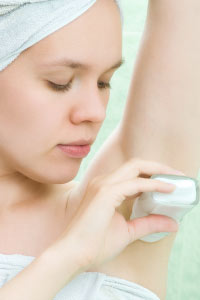 Working up a sweat is a great way to get healthy and feel good. However, smelly, dripping wet underarms aren’t very desirable. Commercial deodorants keep you dry and smelling fresh, but they can contain harmful ingredients too.
Working up a sweat is a great way to get healthy and feel good. However, smelly, dripping wet underarms aren’t very desirable. Commercial deodorants keep you dry and smelling fresh, but they can contain harmful ingredients too.
6 Toxic Deodorant Ingredients to Watch Out for
1. Aluminum – Aluminum compounds, such as aluminum chlorohydrate and aluminum zirconium, stop you from sweating by blocking your pores. Aluminum has been shown to affect hormone levels and reproductive ability in rats. Some studies seem to show that aluminum contributes to Alzheimer’s disease, but scientists aren’t entirely sure about this. “Natural” deodorant crystals or stones can contain aluminum, so be careful.
2. Triclosan – Bacteria on your skin feed on your sweat, which gives it a bad smell. To get rid of this smell, some deodorants contain triclosan, which kills bacteria and fungi. Many studies on animals show that triclosan disrupts the endocrine system. Exposure to triclosan is associated with an increase in seasonal allergies.
Quiz: Is Your Body TOXIC? Take the Test...
(get your free personalized report)
3. Phthalates – Phthalates help your deodorant cling to your skin. They are known endocrine disruptors. Phthalates are used in plastics to make them more flexible. In the European Union, it’s illegal to use some phthalates in children’s toys.
4. Parabens – Parabens kill fungi and bacteria. They are used as preservatives in many cosmetic and skin care products and in prepared foods. Studies show that parabens are endocrine disruptors that mimic estrogen and affect thyroid hormones.
5. Propylene glycol – Propylene glycol helps your deodorant penetrate your skin. It can cause skin irritation. Some “natural” deodorants contain propylene glycol.
6. Fragrance – The fragrances added to deodorants can cause allergies. They can irritate the skin and respiratory system.
Does this mean you can’t stay dry unless you expose yourself to toxic chemicals? Of course not! Here are some clean and effective alternatives to commercial deodorants.
Quiz: Is Your Body TOXIC? Take the Test...
(personalized report)
5 Clean Deodorant Alternatives
1. Baking soda and cornstarch – Dab a mixture of baking soda and cornstarch under your arms. The baking soda will get rid of any bad smell and the cornstarch will eliminate wetness. If you prefer, you can use arrowroot instead of cornstarch. Add coconut oil or olive oil to the mixture for their moisturizing, antioxidant and antibacterial properties.
2. Rubbing alcohol – Rubbing alcohol kills odor-causing bacteria. It is an astringent. That means it shrinks your pores and prevents you from sweating. Avoid using rubbing alcohol, or any other astringent, right after you’ve shaved.
3. Lemon juice – Lemon juice is also an astringent. In addition to having its own refreshing scent, lemon juice contains citric acid, which kills the bacteria that cause odors.
4. Tea tree oil – Another astringent, tea tree oil has antiseptic properties and a refreshing smell. High levels of tea tree oil can cause skin irritation and allergies in some people, so take care if you have sensitive skin or are allergy-prone.
5. Witch hazel – Witch hazel is also an astringent. It contains substances called tannins, which are antioxidants.
Do you really need deodorant?
A recent UK study showed that 78% of people with a gene that prevents them from having body odor use deodorant anyway. These people must be using deodorant because they’ve been influenced by advertising, not because they really need it.
You can help avoid body odor by showering regularly and watching your diet. You will find that eating certain foods can make your body odor worse.
Caffeine makes you sweat more, so try lowering your caffeine intake.
Additional sources:
Aluminum and Alzheimer’s Disease: After a century of controversy, is there a plausible link? (Journal of Alzheimer’s Disease)
Ban of phthalates in childcare articles and toys (European Commission)
Caffeine Increases Sweating Sensitivity via Changes in Sudomotor Activity During Physical Loading (Journal of Medicinal Food)
